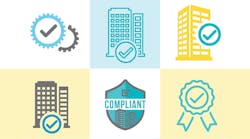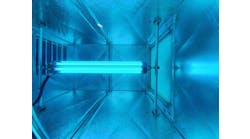The built environment’s impact on climate, society, the economy, ecosystems, and occupant health and well-being can be linked to factors that today can be measured and verified through standards, certification programs, and rating systems. The panoply of “scorecards” is increasingly useful for commercial real estate portfolio owners and operators to hit ESG targets and demonstrate value to investors and tenants.
However, pursuing certification can be time-consuming and costly. The good news: Certification programs are evolving to offer more options and to become more simplified to increase accessibility for smart projects of all types and sizes. All this while keeping an eye on leveraging technology and maintaining relevance.
The role of smart building technologies
Building certifications largely fall into one of three categories: sustainability, health and wellness, or technology. Overlap does occur, and nearly all programs today reference smart building technologies due to the latter's role in reaching and measuring objectives.
The International Living Future Institute's (ILFI's) Living Building Challenge (LBC) bases its system on seven petals—place, water, energy, health and happiness, materials, equity, and beauty—but technology has an understated role. “We are agnostic in terms of which technology and how much technology is needed, but there are areas where certain technologies are vital to accomplishing what we’re asking for,” says ILFI CEO Lindsay Baker. “For example, we require energy metering, and controls and sensors are needed to achieve indoor air quality and lighting comfort.”
Technology also helps buildings achieve Fitwel certification, which looks at seven health impacts: surrounding community health, reducing morbidity and absenteeism, supporting social equity for vulnerable populations, instilling a feeling of well-being, enhancing access to healthy foods, promoting occupant safety, and increasing physical activity.
“We don’t tell clients what technologies to use, but we guide them on achieving key performance parameters through technology, such as using sensors to monitor indoor air and water quality or to understand who is using space and how,” says Zachary Flora, Fitwel vice president of market growth. “In a way, Fitwel itself is a smart building technology in that it aggregates a range of data to help building owners make informed decisions.”
After introducing the BEST Smart Buildings certification in April 2021, BOMA Canada recently signed a letter of intent with BOMA International to launch the program stateside. BEST considers six key indicators: analytics and artificial intelligence, cyber and physical security, data management, connectivity, health and well-being, and sustainability. It leads with a detailed questionnaire specific to the project type that might ask about security and safety, operations and management (O&M), network and integration, end-user experience, and reporting and analysis. Third-party verification follows.
According to Benjamin Shinewald, president and CEO of BOMA Canada, many questions reference technology elements. For example, the O&M section asks, “Is the HVAC system integrated with air quality and weather information?” In the end-user experience section, “Is a digital concierge available?”
The U.S. Green Building Council’s (USGBC’s) LEED version 4.1 program awards points for metering building energy performance and indoor air quality, advanced lighting controls, and running 95% of the electrical load of at least one primary energy system with direct current power.
Making certification easier and accessible
Certification is a significant undertaking that is not always feasible for stakeholders. Application fees themselves can be financially beyond reach, which has led some teams to denote their projects as “designed to meet” rather than pursuing official certification.
BOMA BEST's lowest level is awarded to buildings that hit core, minimal best practices. From there, buildings can accumulate additional points to achieve Bronze, Silver, Gold, or Platinum certification.
For portfolios, BOMA verifies policies to ensure portfoliowide compliance with BOMA BEST standards and then verifies 20% of the portfolio annually. “Each building within the portfolio must complete an individual assessment and we then verify the first 20% of buildings in Year 1,” Shinewald explains. “Once this sample is verified, the entire portfolio is certified. To maintain portfolio certification, we then verify the next 20% in Year 2, and so on until Year 6 when the first 20% are re-verified and the cycle continues. This makes the approach flexible and predictable.”
Fitwel has no prerequisites and offers certification strategies for different project budgets, profiles, and building ages. The registration fee is $500, and certification fees vary with project size. “We originally had one scorecard for workplace buildings, but COVID changed the game with more companies seeking to verify the health of their buildings,” Flora says. “We now have multiple site and building scorecards to accommodate a broader range of customers.”
The scorecards now cover communities and commercial/industrial sites, senior housing, multi-tenant base buildings, multi-tenant whole buildings, single-tenant buildings, commercial interior space, retail, and multifamily residential buildings.
Developed by the International WELL Building Institute (IWBI), WELL certification is based on the full WELL building standard, which spans 108 features across 10 concepts: air, water, nourishment, light, movement, thermal comfort, sound, materials, mind, community, and innovation. Projects can achieve WELL certification at different levels—Bronze (40 points), Silver (50 points), Gold (60 points), and Platinum (80 points)—but IWBI recently whittled down its full standard into smaller, more targeted work scopes to offer a WELL Health-Safety Rating, a WELL Performance Rating, and a WELL Equity Rating.
“We started this effort at the onset of the pandemic for companies to create confidence in the health and safety of their facilities, and we expanded that approach to address trends like using health performance metrics and ensuring DEI [diversity, equity, and inclusion],” says Jessica Cooper, IWBI chief product officer. The organization also introduced a cost-effective WELL at scale program where companies can receive a WELL score based on an aggregated calculation of points achieved across multiple sites.
While not uncommon for properties to seek more than one certification, choosing programs that complement each other and avoid duplication of effort is difficult. Last November, IWBI announced it was expanding its partnership with the USGBC to streamline the process for dual WELL and LEED certifications. “Sustainability and health and wellness as broad goals are complex and multifaceted,” Cooper says. “We have to tackle people and planet, and companies that do one or the other are missing out.”
For organizations that might struggle to achieve all seven petals of the LBC or want to focus on one goal, ILFI now offers Core Green Building, Zero Carbon, and Zero Energy certifications. It also provides individual Petal certifications for materials, energy, and water.
“We often see organizations start with the aspiration of achieving full LBC certification and realize that one aspect or another is cost prohibitive or logistically infeasible,” Baker says. “Many ESG goals and science-based targets for regulations also often center around a specific priority, such as carbon footprint. Aspects of the full [LBC] go beyond those goals and can be difficult to achieve.” She adds that all ILFI certifications share a set of basic requirements, so organizations should not feel lessened for tackling one goal at a time.
Regularly revisiting the application and verification processes has also made certification more accessible. According to Jules Barker, global director of products at WiredScore, SmartScore has been modified since its April 2021 inception. “We were taken aback by how much harder clients found it to get through the SmartScore process compared to WiredScore,” he says. “We therefore simplified the language and developed a best practice guide that walks through the requirements, criteria by criteria, to help clients understand what they need to do to get credits for a category. For example, we removed the need for an API [application programming interface] in some cases and replaced it with the need for systems to communicate.”
The SmartScore certification scorecard is premised on user functionality and technology foundations. User functionality looks at the extent a building delivers outstanding outcomes for individual and collaborative productivity, health and well-being, communities and services, sustainability, O&M, and security. The technology foundations assess connectivity, building systems, integration, governance, cybersecurity, and data sharing; they also help buildings achieve functionality outcomes by introducing specific technologies via partnerships.
“We do not give points for one technology versus another if they have the same outcome,” Barker says. “But some of our clients struggle with where to start. If I do a Google search for space optimization sensors, thousands of them exist. We give our clients a list of companies and individuals that have experience in leveraging specific technologies.”
The Telecommunications Industry Association (TIA) and UL are also working to improve their 2020-launched SPIRE Smart Building assessment and rating program, which looks at six criteria: connectivity, health and well-being, life and property safety, power and energy, cybersecurity, and sustainability. In December 2022, UL launched a new qualification program for third-party building professionals to earn SPIRE-qualified assessor status.
“A fully verified SPIRE assessment is a big effort for auditors, and some clients want to time their assessments with events and a communications strategy,” says TIA Smart Buildings Program director Marta Soncodi. “We need to do as much upfront work as possible and speed up the verification audits. The new qualification program will mean more auditors to help achieve those goals and expand the program.”
The relevance and value of certification
In a competitive market with more than 100 building certification programs worldwide and increasingly more assets seeking certification, expanding accessibility and easing certification processes are not enough. Certification programs must also remain relevant and demonstrate tangible value beyond a plaque on the wall.
To that end, SmartScore and SPIRE expect to launch new versions of their criteria by year’s end. “We are working to clarify and streamline questions based on feedback from multiple assessments and trending ESG initiatives and technologies,” Soncodi says. “For example, we are adopting aspects of the ISA/IEC 62443 OT cybersecurity standard to address building operational systems and adding new technologies like fault-managed power, microgrids, and Wi-Fi 6 rather than Wi-Fi 5.”
“After only one year, it’s too early for analytical evidence regarding the financial uplift in the market of SmartScore buildings, but there are plenty of case studies that show how a technology provided tangible benefits,” Barker says. “SmartScore is intended to be a badge of success and act as a roadmap for clients, demystifying the technology, and supporting them on the journey from idea to implementation.” Meanwhile, WiredScore, founded in 2013, has successfully shown results based on a decade's worth of data; for example, research found that vacancy for WiredScore-certified properties was 3.8% lower than noncertified properties; for New York locations, rent was 2.7% higher.
Research has been conducted on other certifications. Last year, a study of 20,600 U.S. office buildings by commercial real estate services and investment firm CBRE found that those with LEED certification commanded an average rent premium of 4% during the economic downturn between 2019 and 2022. A study by Cushman & Wakefield found that LEED-certified assets had a 21.4% higher average market sales price per square foot than noncertified buildings over the past three years.
A study in the Journal of Building and Environment found that WELL certification increased overall occupant satisfaction by 30% along with increasing perceived mental and physical health, well-being, and productivity. IWBI also summarized findings from nearly 60 independent studies that tied higher ventilation rates to an 8% uptick in employee performance, including one that demonstrated a 300% ROI for workplace wellness programs.
With a decade of certifying projects under its belt, ILFI is also working toward providing annual reports on its certifications and qualifying and quantifying the impact of the LBC. Local, state, and federal regulations have helped, Baker says; for example, Seattle’s Living Building Pilot Program allows for additional height and floor area ratio from the Seattle Land Use Code for projects meeting the LBC.
“We absolutely try to make the process easier on the wallet, but at the end of the day, the highest priority is saving our species and planet,” Baker says. “If we build buildings that use more electricity or put chemicals into the environment, that cost is borne by society somewhere along the line.”
For more news, projects, and profiles in the smart buildings ecosystem, subscribe to the SBT newsletter and follow us on LinkedIn, Twitter, and Facebook.



